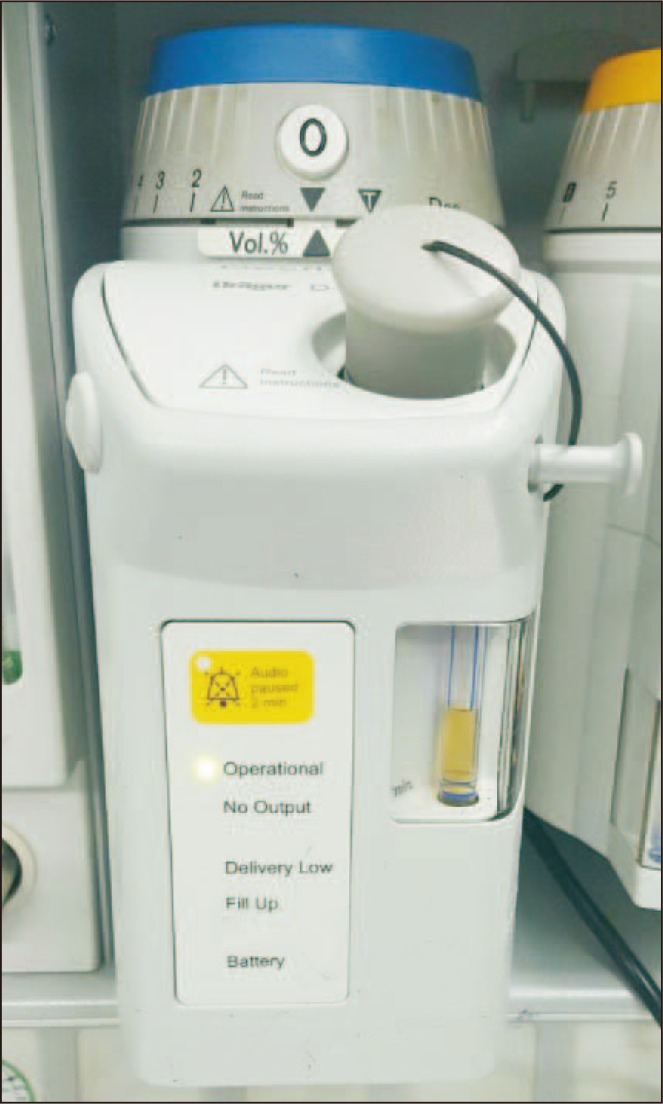 |
 |
|
|
One afternoon during surgery, we observed that the desflurane (Suprane┬«, Baxter Healthcare, Puerto Rico, USA) in the Dr├żger vaporizer (Dr├żger D-vapor, Dr├żger Medical GmbH, L├╝beck, Germany) had turned yellow while filling the vaporizer (Fig. 1). We immediately changed the vaporizer. Yellow discoloration of desflurane occurs relatively infrequently and is not widely known; however, this was the second incident in our hospital.
The yellowing of desflurane is due to by-products of butylated hydroxytoluene (BHT), which is added in the core gasket of the bottle [1,2]. The bottle of desflurane requires a highly effective closure mechanism because of the low boiling point (23Ōäā) of desflurane. Therefore, the core gasket is sealed with elastomers to obtain optimal sealing and BHT is added as an antioxidant to the elastomers. Small amounts of BHT are dissolved by desflurane, an excellent organic solvent, and enter the vaporizer sump during the filling process. Subsequently, BHT is oxidized in air to form by-products, which have a yellow color. Gradual accumulation of the by-products eventually leads to their visibility.
Our case was different from previous events which were noticed during the machine check in the morning [1,2]. We used the vaporizer without any problems in the morning and the desflurane in the sump of the vaporizer was colorless and transparent as normal. However, the sump turned yellow as soon as we filled the desflurane. At the time, the bottle of desflurane had been placed accidently behind the heat-dissipating fan of the anesthesia monitor machine, which resulted in an increased surface temperature of 43Ōäā, measured by a noncontact infrared thermometer (Microlife NC 100; Microlife Corp., Taipei, Taiwan). Desflurane should be stored at controlled room temperature of 25Ōäā, with permitted range between 15Ōäā and 30Ōäā. The yellow discoloration of desflurane was possibly due to heating of the bottle by hot air from the heat-dissipating fan. The solubility of BHT is correlated with the temperature of the solvent [3]; hence, it is likely that excess BHT was dissolved by the heated desflurane during filling of the vaporizer. As the concentration of by-products increased, the color changes were accelerated.
Ilsung Pharmacy, the official reseller of Suprane®, picked up the vaporizer and bottle for drainage and cleaning. The yellow discoloration of desflurane is not associated with contamination or any confirmed pharmacovigilance safety signal because of its negligible volatility [2,4]. Nevertheless, concerns about patient safety remain [5]. Baxter is currently redesigning the valve system of the bottle to replace the elastomeric components [4]. It is important to recognize the discoloration phenomenon and utilize the manufacturer's services for removal of accumulated by-products from the affected vaporizer. Additionally, desflurane should be stored at room temperature to prevent accelerated solubilizing of the BHT and consequent discolorations of desflurane.
References
1. Lobaz S, Randles D, Thomas D. Desflurane vaporiser contamination. Anaesthesia 2014; 69: 190-191. PMID: 24443867.


2. Kanazawa M, Watanabe M, Suzuki T. Yellowing of desflurane in the vaporizer. J Anesth 2015; 29: 648PMID: 25588675.












